
Published on the occasion of the exhibition
Landmarks and Lifeforms
by Frieda Meaney and Danny OsborneUillinn: Skibbereen ,West Cork. March/ April 2017
Limerick City Gallery, Limerick. September /October 2017
Highlanes, Drogheda, Co, Louth. February/ March 2018
© the artists and the authors
Design: Fiona O’Reilly, On the Dot Design www.onthedot.ie
Front cover image: Danny Osborne and Frieda Meaney
Mater: (detail of the collaborative print)
Landmarks and Lifeforms, an interdisciplinary installation by Frieda Meaney and Danny Osborne.
Introduction
Curiosity and collaboration are the hallmarks of this intriguing two-person exhibition of painting, print, video installation and sculpture by Danny Osborne and Frieda Meaney. The artists worked with scientists to explore the realms of geology, ecology, biology in a drive to investigate and explore new physical and conceptual topographies; they collaborated with each other to create a large printwork entitled Mater, and with curators and gallery educators to present the exhibition and their ideas and concerns in three, very different venues.
Initiated and developed by Uillinn: West Cork Arts Centre and exhibited there from 11 March to 20 April 2017, Landmarks and Lifeforms was presented in different
iterations at Limerick City Gallery of Art (7 September to 22 October 2017) and Highlanes Gallery, Drogheda (3 February to 14 April 2018) with the support of the Arts Council’s Touring and Dissemination of Work Award.
The exhibition was accompanied by broad and diverse creative learning programmes at each of the three venues, including talks and panel discussions featuring the artists and scientists from various fields of marine biology, zoology and ecology; dance performances and music recitals in response to the exhibition; family and schools programmes and a Discovery Box gallery resource for very young children. Throughout, Landmarks and Lifeforms was a rich source of learning, an invitation for exploration and an inspiration for the curious mind.
Ann Davoren Director, Uillinn: West Cork Arts CentreFrieda Meaney
Pangaean Dream: diptych, oil on canvas/screenprint on perspex, plants
150 x 200 cm



Frieda Meaney
Cretaceous Demise: diptych, oil on canvas/screenprint on perspex, plants
150 x 200 cm

Frieda Meaney
Natura non Facit
(nature does not make leaps): oil on board/screenprint
100 x 100 cm


Heads-Up: Human: Chameleon: Digital duratran print, collage, ash case, left - right
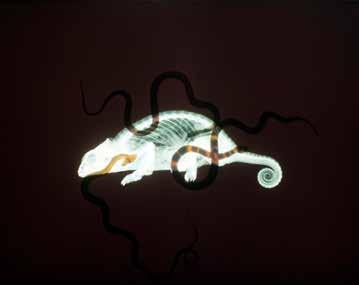

52 x 38 cm

Heads-Up: Turkey: Gorilla: Digital duratran print, collage, ash case, left - right 52 x 38 cm




Frieda Meaney
I search for lost Worlds installation structure detail: screen print, perspex

Opposite page: Frieda Meaney
I search for Lost Worlds (still): installation: video 3.53mins. looped perspex revolving structures, plants www.youtube.com/watch?v=A6KStR4wdJk




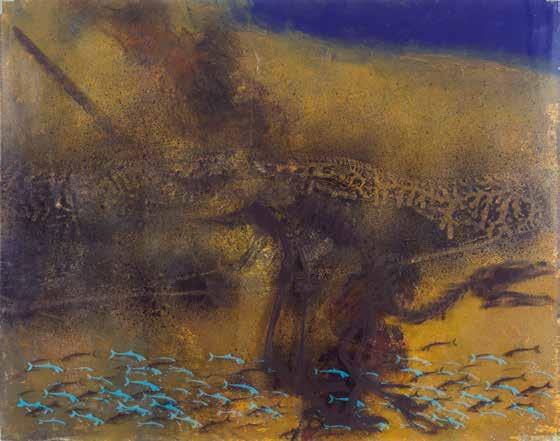
Casting off in New Territories: shed snakeskin, box, screenprint, glass lens variable dimensions

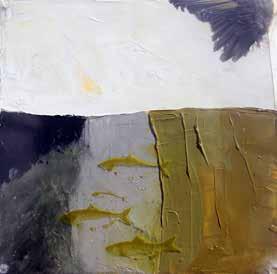



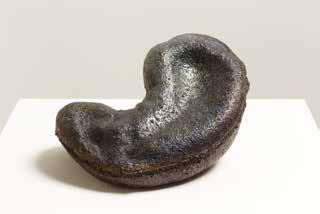

Frieda Meaney and Danny Osborne
Mater:
6 collographs by Danny Osborne
6 screenprints by Frieda Meany. collaborative work commissioned by Uillinn: West Cork Arts Centre.

Gallery Installation, Highlanes

Gallery, Drogheda, Co. Louth
Photography: Eugene Langan



Danny Osborne
Fin’s Journey: whale ribs, engraved and filled with red ochre and whale oil
182 x 166 x 20cm

Frieda Meaney
The visual and artistic expression of biology as employed in the work of Frieda Meaney is inspired by the ecosystem as a natural system consisting of plants, animals and micro organisms functioning together within the environment. She depicts the ecosystem in an intuitive way that is inspired by scientific disciplines. She works with images of living and extinct marine, terrestrial and airborne creatures in a way that blurs the lines between their respective realms to create work that portrays an idealistic and imaginative environment.
Her video installation for this exhibition mixes footage of endangered species of fish taken in an aquarium on the island of Tenerife, with the soundtrack of a chorus of birds in a South American jungle. The printed skeletal images of dinosaurs, reptiles and birds, revolving across and layered on the video projection, suggest an evolving world which is constantly changing and adapting to environmental circumstances.
www.friedameaney.com
www.friedameaney.tumblr.com
photo: Frieda Meaney in her studio, Beara, Co.Cork

Danny Osborne
Danny is probably the first person to use molten lava flowing from a volcanic vent to create sculpture, which he feels is a deeply symbolic artistic gesture. The whole surface of the earth was covered with lava four billion years ago. It slowly cooled over many millions of years and metamorphosed into all the minerals, rocks, water and lifeforms, including us. He says, “when I form a sculpture from molten lava, it takes a mighty great leap in time from the creation of the earth to the brutality of the conquistadors or the nurturing of a baby’s bottle of milk.”
Danny has also made work which explores how the Arctic region is represented, historicised, and mapped now and in the past. This locative concept is used again when he spent six days drawing the coastline while on a local crab boat travelling between the Bull Rock right across to the Mizen in Cork. The resulting engraved drawings on the huge bones of a Fin whale represent the land marks that this whale would have referenced while navigating along this coast before eventually being stranded.
www.dannyosborne.com
Photo: Danny Osborne and Fin’s Journey Whale Ribs, engraved and filled with red ochre and whale oil (detail)

Manchán Magan, Opening of Landmarks and Lifeforms at Uillinn: West Cork Arts Centre on 10th March 2017
Mianach is an Irish word meaning the essence of something, the bones, the kernel, the underlying rock. Both artists represented in the Landmarks and Lifeforms exhibition, Frieda Meaney and Danny Osborne, are attracted to the mianach, the core nature of things. And as a result their art is a rooted and reassuring one.
While Eastern cultures have their seers and we in the West have our scientists, occasionally both worlds are fortunate enough to have an artist come through who can navigate the deepest realms of the numinous and the empirical science and help guide us towards a deeper understanding of both.
This is what we get with these two artists, Frieda and Danny, who are so rooted in the Beara Peninsula and so committed to exploring themes and dimensions far bigger than themselves. They have both gone out into the world with open hearts and minds and digested all that is about them - the multi-layered and multi-dimensional wonder of it all - and have condensed it down into a few singular works of creative expression.
Danny’s fin whale bones have a visceral effect. One has an uncanny sense when in their vicinity that part of one’s unconscious is being awakened. Likewise Frieda’s installation I search for Lost Worlds consisting of a film projection with circular etchings of animal, reptile and dinosaur bones could also easily entrap one under its spell.
Both artists create art that feel like they could swallow us whole, like poor Jonah; transporting us elsewhere. Their work is potent and demands to be savoured.....
Manchán Maganhttps://www.westcorkartscentre.com/landmarksandlifeforms
As a scientist I believe most of us have an inherent interest in wildlife in general, probably because we were all hunters and gatherers once and we needed to have an interest in our natural surroundings, and birds in particular because of their aesthetic appeal. Frieda mentioned they have a link with dinosaurs; they are in fact direct descendants of dinosaurs, which is remarkable. They are interesting behaviour wise, such as the bowerbird of Papua New Guinea, which creates elaborate structures to attract a mate, much in the way an artist creates art with a view to attracting interest from the public. I think there’s a really nice parallel there.
In recent years I have begun to see how strong the similarities are between what we as scientists do and what artists do: we explore and tease out details, develop ideas and eventually become obsessive in a creative kind of way, which is just what happened to Frieda when she got lost in our little museum at BEES and became fixated on one particular group of exhibits, the skulls of toucans and hornbills.
The very title of this exhibition Landmarks and Lifeforms is pretty much the definition of what ecology is, the interaction of animals (lifeforms) and their environment (landmarks); and for me, the parallel between an ecologist’s and an artist’s work in terms of innovation as a fundamental approach is really quite striking.
John QuinnWe go through the world, it seems to me, we humans, possessed by the need to take the language of a thing being itself and transform it into a language we can share. We single something out, we consider it, and then we re-insert it in the plenum - as Danny did, when he cast a Conquistador’s helmet in living lava.
Consider that tall collaborative piece with the beautifully printed skulls of birds, and then that piece of brain coral: the coral was perfectly happy being itself, it didn’t need a name, it doesn’t care, doesn’t know how to care, whether it resembles a human or animal brain - but we do, because Frieda saw the graphic possibilities, the associative, metaphoric possibility in that resemblance. We see it, because she did.
When we do this sort of thing, we are asserting that we belong in the world, by virtue of what we do for others. The artist, the writer, the musician, the scientist, cannot exist in a solipsistic state; there must be, for them, always a gesture of communication towards an “other”, known or unknown.
Somewhere along the line, humans became separated from the totality of what is. We are always trying to heal that wound, we’re always trying to talk ourselves back to the world - to remind and re-assure ourselves that science is nature, that the plane flying overhead is nature, that the painting is nature, everything is nature. That is the work Frieda and Danny are doing: healing the wound.
Theo DorganExtracts from the panel discussion which took place on 1st April 2017, Uillinn, West Cork Arts Centre.
Special Thanks to the contributors who participated in the panel discussion groups as part of touring ‘Landmarks & Lifeforms’ in Uillinn, LCGA and Highlanes Galleries. 2017-18
‘It is not the strongest of the species that survive, nor the most intelligent, but the one most responsive to change‘
1. Manchán Magan is a writer and documentary-maker. He has written books on his travels in Africa, India and South America and two novels. He writes occasionally for The Irish Times, reports on travel for various radio programmes, and has presented dozens of documentaries on issues of world culture for TG4, RTÉ and Travel Channel. He lives in his oak forest in a selfmade hovel in Westmeath. www.manchan.com
2. Professor John Quinn primarily an ornithologist with a strong interest in animal behavior and evolution, John has worked on a whole range of pure and applied topics in different kinds of ecosystems, from marine, estuarine and wetland to farmland, upland and woodland. bees@ucc.ie
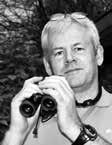

3. Theo Dorgan Poet, prose writer, editor and translator, he has also written scripts for film documentaries and worked as a presenter of literature programmes on radio and television for over 25 years. Theo Dorgan is a member of Aosdána. www.theodorgan.com

4. Dr. Simon Berrow Technology and founder member and current Chief Executive Officer of the Irish Whale and Dolphin Group.

5. Dr. Maria McNamara in Geology in the School of Biological, Earth and Environmental Sciences at University College Cork. Her research focuses on the preservation of soft tissues in animals, in particular the preservation and evolution of feathers in dinosaurs and the fossil record of animal coloration.
6. Eanna Ni Lamhna has a degree in Botany and Mircobiology and a H. Dip in Education from UCD. She is a long-standing member of the panel of experts on RTÉ’s wildlife programme ‘Mooney goes Wild’. She is firmly on the side of wildlife and biodiversity in this new world of climate change.
www.westcorkartscentre.com/landmarksandlifeforms
7. Dr. Susan Steele Authority Chair SFPA Sea, Fisheries Protection Authority, Ireland. Dr. Steele currently sits on the Wildlife Committee of the Heritage Council, Business Advisory Council in UCC and the Public Sector Innovation Forum. www.sfpa.ie


ATTRIBUTED TO CHARLES DARWIN
The exhibition and touring programme was made possible through the hard work and imput of the galleries involved and their teams of administrators, P.R staff, educators, photographers, technicians and invigilators and the support of the Arts Council of Ireland’s Touring and Dissemination of Work Award.

Director Ann Davoren
Uillinn
West Cork Arts Centre, Skibbereen, Co. Cork, Ireland
T+353 2822090
E info@westcorkartscentre.com
W.www.westcorkartscentre.com


Director Una Mc Carthy
Limerick City Gallery of Art
Carnegie Building, Pery Square, Limerick.
T: +353 (0)61 310633
E: artgallery@limerick.ie
W: www.gallery.limerick.ie
Director Aoife Ruane Highlanes Municipal Gallery
Laurence Street, Drogheda, County Louth, Ireland
T. +353 (0) 41 9803311
E. info@highlanes.ie
W. www.highlanes.ie
Credits
Frameworks films
https://vimeo.com/208136588
Roland Paschhoff: 2/3, 4/5, 6, 7, 9, 10, 11, 14/15, 17, 18, 22, 24/25, 27
Geraldine Osborne: page 20
Samuel Laurence Cunnane: page 28
Tomasz Madajczak: page 23
Leah Mersky: pages 12, 21
Eugene Langan: Page 15
Toma McCullim: artist, facilitator of workshops and creator of Discovery Box that accompanied the exhibition throughout the tour

